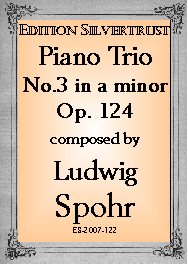Presents
Louis Spohr
Piano Trio No.3 in a minor, Op.124
 Louis
Spohr (1784-1859 also known as Ludwig) was born in the German city of Braunschweig. From early childhood, he showed a great aptitude for
the violin. He studied with the virtuoso violinist Franz Anton Eck
in St. Petersburg and ultimately became one of the leading
violinists in the first half of the 19th century. It was at a
concert in Leipzig in December 1804 that the famous music critic
Friedrich Rochlitz first heard Spohr and pronounced him a genius not
only because of his playing but also because of his compositions.
Literally overnight, the young Spohr became a household word in the
German-speaking musical world.
Louis
Spohr (1784-1859 also known as Ludwig) was born in the German city of Braunschweig. From early childhood, he showed a great aptitude for
the violin. He studied with the virtuoso violinist Franz Anton Eck
in St. Petersburg and ultimately became one of the leading
violinists in the first half of the 19th century. It was at a
concert in Leipzig in December 1804 that the famous music critic
Friedrich Rochlitz first heard Spohr and pronounced him a genius not
only because of his playing but also because of his compositions.
Literally overnight, the young Spohr became a household word in the
German-speaking musical world.
Besides frequently touring as a concert violinist, Spohr held many important positions as a conductor and director at various musical courts throughout Germany. From the very beginning, Spohr wanted to become more than just a violin virtuoso. Hard work and talent were to allow him to become a leading conductor, a highly regarded composer and a famous violin teacher. As a conductor, he pioneered the use of the baton and introduced the practice of putting letters into parts to aid rehearsal. Violinists should be forever be grateful to him not only for his fine concertos but also because he invented the chin rest.
Spohr wrote in virtually every genre, not the least being chamber music. He composed some 36 string quartets, 7 string quintets, five piano trios, four double quartets and several other chamber pieces. His teaching assistant related that as the 1830ís he bemoaned his lack of ability on the piano and said that he would gladly trade a yearís salary to be able to play the piano well. Spohr was truly a great man of many skills (mountaineer, hiker, painter et. al.), and nothing if not determined. Sometime during the late 1830's he undertook a rigorous course of study of the instrument and by the 1840ís had become a good, if not great, pianist. The main result of this was that he was able to compose chamber works with piano, such as his Piano Trio No.3, which were to have lasting value
Piano Trio No.3 was completed 1842 and published not long after. The dramatic opening of the Allegro moderato, begins with a theme of pathos. This is immediately followed by a highly romantic theme. In the second movement,Andante con variazione, Spohr chooses a fine folk ballad for his theme, which proves capable of withstanding the wide-ranging treatment it is given. The Scherzo which comes next is of the sort in which Spohr was a master. It might be called the flip-side of the Mendelssohnian scherzo with its elves and fairies. Spohr's scherzos are haunted and tend to feature ghosts and ogres. The constrasting trio is more ethereal. The finale, Presto, seems to take up where the Scherzo leaves and begins with a haunted "march of the goblins." Full of exciting and bizarre twists and turns, it provides an excellent conclusion to what is one of Spohr's very best chamber works.
This trio is full of original ideas, excellent part-writing and has none of the peculiarities which unfortunately often mar many of his works. It truly belongs in the concert hall and will certainly please amateurs as well. Our edition is a reprint of the original and only published edition which is over 160 years old. We have corrected errors and added rehearsal numbers. Though it is perfectly readable and makes a serviceable performance edition, like most editions which were set before 1860, it is not up to modern standards. The price, less than our generally very low prices, reflects this fact.
Parts: $24.95